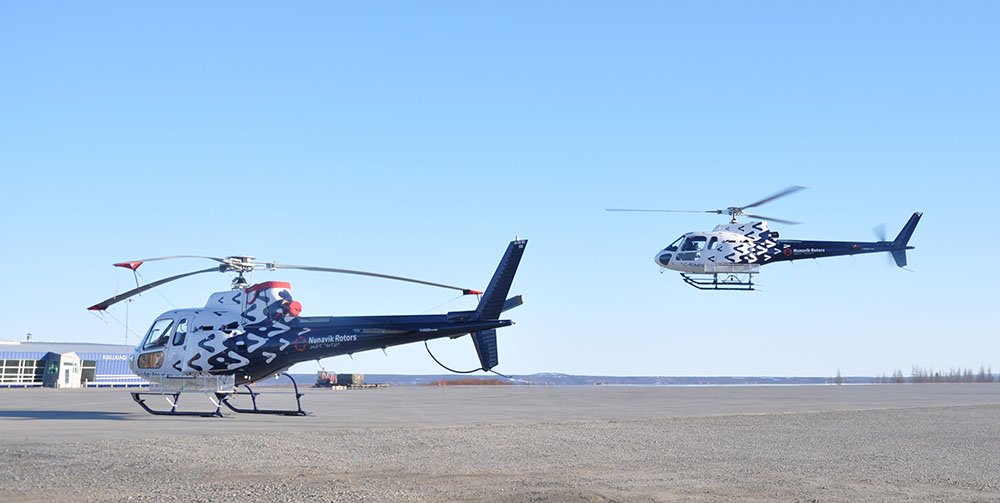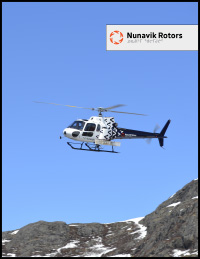Northern Quebec’s Rescue Heroes
By Rajitha Sivakumaran
Home to the Inuit, 507,000 square kilometres of Quebec’s northern territory boasts a wide array of attractions for those wanting to experience the great outdoors. Collectively referred to as Nunavik, the vastness of this Arctic terra firma can seem a bit alarming even to an experienced adventurer, but a land filled with tundra, taiga forest, mountains and unique wildlife is nonetheless eye-catching.
So explorers flock to the terrain, but sometimes adventure stories can have hazardous endings when the unexpected happens and the weather becomes aggressive. In fact, even the seasoned locals fall victim to nature’s violent tempers. Other times, simple things like a snowmobile without fuel can leave people stranded without food and warmth.
When things take a turn for the worse, locals and explorers alike can depend on Nunavik Rotors, the 100 percent Aboriginal-owned helicopter division of Air Inuit, for search and rescue. As operations manager, chief pilot and vice president of this Kuujjuaq-based enterprise, Peter Duncan has been flying for over 20 years and has witnessed his fair share of successful rescues and inconsolable denouements.
“There are quite a few stories. Every year we go looking for people,” Duncan said.
Many times, Duncan has flown out searching for people who had been stranded after their snowmobile had run out of fuel, eventually finding them using their snowmobile tracks. In one instance, the person had abandoned his vehicle and had commenced walking, which made him particularly difficult to track. By the time Duncan had caught up to him, he was alive but severely frostbitten and in poor shape.
Another intensely difficult rescue mission involved five people who had been stranded on pieces of ice after a boating accident in the bay. The problem was that there was no place to land the helicopter. Duncan had to bring the aircraft close enough to allow the boaters, who were hypothermic by that point, to climb aboard.
Sometimes even though all measures are taken to ensure that fuel deficiency doesn’t become a problem, nature calls without warning. In the case of Inuit whale hunters who had gone out to sea, unexpected delays like a storm forced them to stay adrift for longer than anticipated. Here, Nunavik Rotors was charged with the task of delivering essential items to the hunters.
Tourists tend to be less aware of the hazards of the environment than locals and are especially prone to sticky situations. When the company dropped off hikers in the Torngat Mountains area, the plan was to make the return trip via ski. Unfortunately, these hikers got caught in a severe storm. Although the weather was terrible, as soon as there was a window of opportunity, Nunavik Rotors sent out a rescue team.
There is no other helicopter company in Kuujjuaq. “The service that we provide, it’s a specialized form of transportation,” Duncan said. “Being available for search and rescue, that to me is one of the most important aspects of our service.”
Secret to success in the Arctic
In the 1970s and 1980s, helicopter companies were not rare in Kuujjuaq, but the period following it saw a decline. In response to this disparity, Nunavik Rotors was founded in 1998 as a joint venture with Air Inuit, which remains to this day as the parent company. As part owner of the company, Duncan has been part of the team since its founding, and the beginning humbly consisted of a man-machine trio, Duncan, one engineer and one helicopter.
“It was a tight start, but that was the only way to go,” Duncan said.
Now there are two helicopters based in Kuujjuaq full time, operated by four pilots and three engineers. In 2010, a sister company was opened in Sept-Îles called Innukoptères, which services the Duplessis region of Quebec with a fleet of four helicopters.
Despite operating during a short season with less than six hours of sunlight, Nunavik Rotors has made a name for itself. What is the secret behind its success? Duncan points to two main things in response. To start with, being diverse with clientele has allowed for success. Apart from the search and rescue missions that it carries out on a year-round basis, the company does medevac and emergency missions, scientific and geological exploration and tour rides. Clients include the Quebec government, the Canadian Wildlife Services, the mining industry and national parks. Additionally, the locals often call for the company’s services when weather ensures that commuting over land is not an option.
This diversification is especially helpful now since the mining industry is currently experiencing a downturn. “The majority of our clientele is the mineral exploration division and the markets are way down, which affects them and in turn it affects us. If they don’t have money, they won’t go to work and they won’t have use for us,” Duncan said.
The second thing behind the company’s success is Duncan’s ability to lead a one-man show when things slow down in the winter. “I do many tasks for the company. In the wintertime when it’s quiet, I can trim right down to basically being operational by myself,” Duncan said. The fact that he contributes to the company as a pilot and in a managerial capacity reduces both cost and dependence. Location is also key for managing costs; being local brings down expenses quite dramatically.
The company has no large plans to expand. For the region it serves, Nunavik Rotors has already reached maximum efficiency. Although a fleet enlargement is possible, Duncan says that this would be a nonsensical move. “The amount of work that’s here and the short season, I think we’ve figured out that the size that we are in is perfect,” he said.
www.nunavikrotors.com







